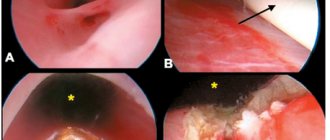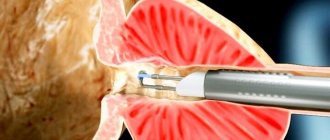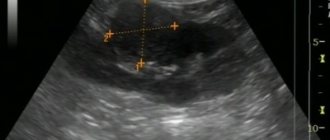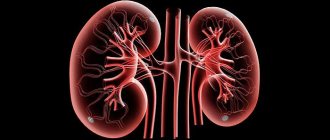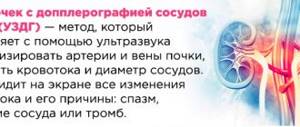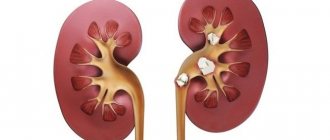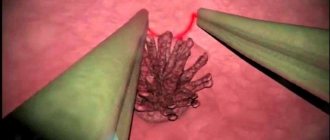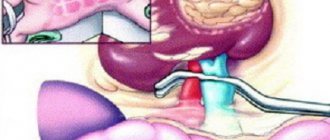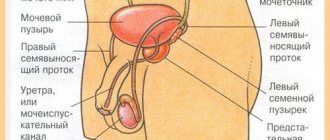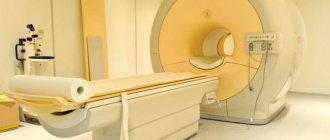Kidney resection is an operation to remove only the affected part of the organ. It is also called organ-preserving. It is carried out in the early stages of the disease, when not the entire organ is affected, for bullet wounds, cancerous tumors, to remove a cyst. Excision is done in several ways, depending on the location of the lesion, the condition of the patient, and his physical form.
Indications for surgery
Surgery is performed in cases where only part of the organ has been affected by the disease and removal of the degenerated tissue will lead to the restoration of the kidney.
Kidney surgery using the “resection” method is prescribed for the following pathologies:
- polycystic disease;
- benign and malignant processes on the organ;
- kidney tuberculosis;
- mechanical damage (knife and gunshot wounds, deep injuries as a result of accidents);
- kidney infarction;
- stones in the parenchyma, nephrolithiasis;
- rapidly progressing benign formations;
- high risk of developing renal failure.
The affected area should be no more than 4 centimeters. Otherwise, complete removal of the kidney is necessary.
The method is based on a positive prognosis: resection is prescribed only if this intervention guarantees 100% recovery of the patient.
You may be interested in – Removing kidney stones: indications, types of surgery, postoperative period
What it is?
In the presence of some urological pathologies, conservative therapy is powerless. In this case, surgical intervention is used, but even in this case, doctors try to eliminate the disease with minimal damage to the patient. If the specifics of the pathology allow, then not the entire kidney is removed, but only its damaged part. The surgeon, cutting off the affected tissue, captures a small part of the healthy one.
Renal resection can be open or laparoscopic, and is performed only under general anesthesia. A drainage tube is inserted into the operated organ and removed only after fluid secretion has stopped. The rehabilitation period lasts up to 1.5 years, depending on the characteristics of the pathology, and requires adherence to diet and drinking regimen, as well as limitation of physical activity.
Contraindications for resection
The group of patients for whom resection is not prescribed, even if indicated, includes pregnant women and patients with infectious infections.
In patients with malignant tumors, resection is rarely prescribed. Since there is a high probability of relapse of the disease if damaged tissue is not completely removed and/or there are deep metastases.
Removal of part of the kidney body is not carried out if blood clotting is low and most of the organ is damaged (as a result of extensive tissue removal there is no chance of restoration of the organ).
Nephrostomy replacement
Changing the tube is necessary because urine contains mucus, salts, and fibrin, which form sediment that impairs the patency of the catheter. The doctor replaces the tube every 2-3 months, on an outpatient basis. But the urinal should be changed independently at least once a week, and more often if an odor appears.
Preparing for kidney resection
Three weeks before surgery, the patient is admitted to the hospital. Without fail, he listens to a doctor’s lecture about the essence of the method and its features. The patient is also referred for consultation to an anesthesiologist.
The patient arrives on the surgical table with an empty stomach.
It is important to ensure that chronic diseases are not in the acute phase at the time of surgery. The presence of bronchitis or pneumonia is unacceptable.
Before surgery, the patient may be prescribed sedatives to prevent hypertension.
Diet and dietary restrictions
After surgery, you must strictly adhere to the diet prescribed by your doctor. If you indulge your whims, the condition can worsen significantly. It is prohibited to use:
- salt, hot seasonings and sauces, marinades and pickled vegetables;
- fried foods, smoked meats, concentrated broths;
- any products with preservatives;
- alcoholic, carbonated drinks and coffee;
- legumes
During recovery, it is recommended to drink kidney infusions. The frequency and dose of taking herbal decoctions is prescribed by a doctor. It is important to consume cranberries in any form. This berry is good for the kidneys and helps restore the organ after surgery. Decoctions of dandelion root, horsetail, and bearberry are prescribed. The volume of fluid consumed should be sufficient, but the kidneys should not be overly stressed.
The diet should be balanced without high-calorie foods. Be sure to consume vegetables, honey, sour cream and eggs. Meat and fish are allowed only in boiled form. At the same time, the protein content should be low, it is recommended to focus on carbohydrates. During the first time after surgery, you should eat mostly vegetables and fruits to stimulate the gastrointestinal tract. Recovery after kidney resection is a critical period. All nutritional nuances at this time should be discussed with your doctor. If the diet is disrupted, serious disturbances in kidney function are possible.
Kidney resection - main methods
Based on the individual characteristics of the patient’s body, the condition of the organ and the degree of its damage, different resection methods can be used:
- laparoscopic kidney resection;
- open partial nephrectomy;
- extracorporeal kidney resection;
- resection of the kidney pole.
Laparoscopic resection
The procedure takes up to 3 hours.
- The patient is placed sideways, with the healthy side on the couch.
- Access is made through the abdominal wall, making 4 small incisions (1–2 cm).
- A camera and surgical instruments are inserted inside.
- The internal cavity is filled with medical gas to increase the access area to the organ.
- Before proceeding directly to the removal, the doctor fixes the renal artery with a clamp for 15 minutes. If the artery is pinched for longer than 40 minutes, the organ will die as a result of starvation.
Once the affected part of the kidney is excised, the surgeon will stitch it up, insert a drainage tube, and remove the gas. External incisions (accesses) are also sutured.
Open resection
The method is used in case of a high body mass index in the patient or for large tumors. For anomalies in the location of the organ.
The patient is placed on the couch on his healthy side, then the lateral part of the lumbar region is dissected. The surgical approach is 10–15 cm in size. During the operation, the abdominal cavity is opened, as are the soft tissues.
When the kidney is isolated, the doctor clamps the arteries and removes the damaged tissue and a small area of healthy tissue connected to it.
After surgery, a drainage system is installed, sutures are applied to the incision site, and then to the side wound.
Extracorporeal resection
This method has a high rate of complications.
But it is extracorporeal resection that makes it possible to excise large tumors and cysts in the middle part of the kidney, without allowing serious blood loss.
During the operation, the kidney is removed from the cavity, and the organ is washed in saline, removing blood from the surface. Then the affected part of the parenchyma and degenerated tissues are cut out.
After all the necessary manipulations, the organ is filled with a blood replacement solution and returned to the abdominal cavity through implantation, and internal and external sutures are applied.
Renal pole resection
Conducted through open access. The only difference from open resection is that access is provided to only one pole of the organ (upper or lower).
When removing a tumor from the upper part of the kidney, it may be necessary to remove the lower rib.
The most important condition is to drink clean water
Due to poor nutrition and the use of medications, toxins are formed in the human body. They are excreted in feces and urine, but the kidneys are not always able to efficiently process them. There is an even greater burden in the case of removal of a paired organ, so it is very important to facilitate the work of the remaining kidney.
First of all, the patient needs to accustom himself to drink only purified water that has been filtered. It is also recommended to use melt water. The daily diet must include at least 30 ml of clean water per 1 kg of patient weight or 7 ml of melt water, respectively.
Obese people should increase their water intake according to the following calculation:
- purified water - at least 40 ml per 1 kg of weight;
- melt water - from 10 ml per 1 kg of weight.
This amount of water is required for daily use, plus the patient must receive additional fluid, which is found in vegetables, fruits, soups, etc.
Drinking enough water will ensure soft stools, while urine will become less concentrated.
Preliminary examination before resection
It is necessary to take general blood and urine tests (average portion) to draw up a complete clinical picture of the patient’s condition. Separately, blood is drawn for tests for the presence of HIV, hepatitis and syphilis infections.
List of specific tests:
- Ultrasound;
- MRI;
- CT scan;
- excretory urography (x-ray of the kidneys with the introduction of a contrast agent);
- chest x-ray;
- angiography;
- perfusion.
Diagnosis before nephrectomy
A blood test is used to detect elevated creatinine levels. CT, MRI and ultrasound of the peritoneal vessels are prescribed to detect vascular thrombosis. The first two manipulations are also carried out for the affected kidney, assessing its condition. Additional damage to organs is determined using x-rays.
It is important that respiratory function is normal, since anesthesia depresses breathing.
Carrying out the operation
The operation is performed under general anesthesia.
- The patient is placed on his healthy side. In some cases, a pillow is placed under the side of the lower back to highlight the kidney.
- After anesthesia, the surgeon makes an incision (the size depends on the resection method chosen by the specialist).
- It is imperative to clamp the leg and blood vessels connected to the kidney to prevent blood loss.
- Removal of the tumor ends with the installation of drainage and layer-by-layer stitching of tissue.
Classification of stones
The stones differ not only in size, but also in composition. They come in 4 types:
The pure type is rare; more often the stones are mixed.
Why do doctors try to determine the type of stone? The tactics and choice of treatment depends on this. Depending on the location, the stones can be single-sided or double-sided. Shape: flat and round, with spikes, coral-shaped and granular. In size - from a few mm to 3 cm and more. But more often the stones are 1.5-2.5 cm. They can form in all parts of the urinary system - in the kidneys, bladder, urethra.
Rehabilitation after kidney resection
The operation is one of the complex surgical procedures.
Therefore, in the postoperative period, it is important to follow all the doctor’s recommendations. Neglect of the regime entails complications.
The patient is in intensive care for a day after the operation, after which he is transferred to a standard ward. At first, the patient takes painkillers. If, as a result of monitoring the condition, the doctor does not identify complications, the drainage system is removed on days 3–5, and after two weeks the external sutures are removed.
After discharge from the hospital you must:
- observe drinking regime;
- give up spicy and heavy foods;
- avoid physical activity;
- be examined by a doctor every 60–90 days;
- treat the seam with an antiseptic and change the bandage;
- keep your body warm.
The doctor may prescribe renal supplements as an addition to the drinking regime. On average, rehabilitation after surgery lasts six months or a year.
Complications
They can occur both after abdominal nephrectomy and after laparoscopic nephrectomy. After abdominal surgery, the following may be observed:
- bleeding;
- thrombosis (in large vessels);
- intestinal obstruction;
- heart or respiratory failure;
- disorders of blood supply to the brain.
During laparoscopic nephrectomy, the following may be observed:
- intestinal obstruction;
- hematomas;
- hernia after surgery (where the trocar entered);
- inflammatory processes in the lungs;
- blockage of an artery in the lungs.
